There’s nothing quite like the magic of a saltwater fish tank with its stunning and unusual fish, mysterious rockwork and beautiful corals.
A glimpse of an exotic coral reef right there in your living room!
So, if you want to know how to start a saltwater fish tank we have all the information you’ll need.
Let’s have a look at how you can go about creating one and what you need to consider before you get started.
Remember though, first and foremost, fish should be treated just like any other pet. You’ll need to care for them, feed them and provide them with the right environment.
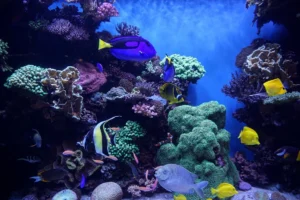
Table of Contents
Research What You Wish to Keep
Well you want to keep fish, right? Yes, of course you do but you may also want to keep corals. You may also want to add invertibrates such as cleaner shrimp, hermit crabs and snails. A star fish maybe?
You need to be aware that not everything is compatible with everything else…
On a large coral reef system in the wild there’s plenty of room for competing fish to thrive, be they predator or prey, as there are plenty of hiding places.
Similarly, crabs, snails and other critters can hide in the rocks and keep out of the way of predatory fish.
Some fish, such as many of the angelfish species, eat corals. Other species, such as trigger fish, specifically feed on snails and crabs, etc.
So, in the closed environment of a saltwater fish tank, extra care needs to be taken and thorough research done to determine what you can safely keep in the same tank.
And size matters! A saltwater fish in your local fish store may only be a couple of inches long now but they can get much, much bigger when they reach adulthood so your tank needs to be big enough to allow the fully grown fish to thrive.
Also, many fish have different dietary requirements, many are meat eaters, others graze on algae or feed exclusively on copepods (tiny shrimp-like creatures).
So, again do your research and make sure you will be able to meet these requirements on an ongoing basis.
Check out our guide, Best Saltwater Fish For Beginners to help you make an informed choice.
Fish Only or FOWLR Tank
A fish-only tank is just that, fish only with NO corals.
Often called a FOWLR tank in the hobby which stands for Fish Only With Live Rock.
This kind of saltwater tank is the easiest to maintain and is probably the best for beginners.
However, that said, if you wish to add corals at a later date do not add any fish that may subsequently eat them.
Size is the most important thing to consider with a fish-only saltwater tank. How many and how big are the fish you wish to keep? This will determine the tank size you’ll need.
Coral Reef Tank
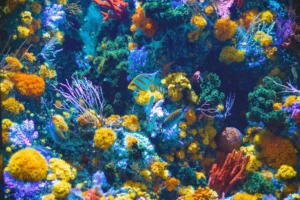
If you wish to start a saltwater reef tank and keep corals, remember they are also live animals that require just as much (if not more) attention and care as your fish.
And just like your fish, different corals have different requirements…
Some require more powerful lighting or flow in the tank, some are more tolerant of higher nutrients in the tank than others and some have special feeding requirements.
Also, note that some corals are aggressive and will sting nearby corals as they fight for space. So you’ll need to make sure you only place certain corals next to each other.
The main types of Coral are:-
- Soft Corals – have fleshy polyps and do not have a hard skeleton. These are the easiest to keep in a saltwater fish tank and can be considered Beginner level.
Common species include; Zoanthids, Mushroom and Toadstool coral, Xenia, Green Star Polyps and Kenya Tree.
- LPS Corals – or Large Polyp Stony corals come in many varieties and are some of the most stunning corals you can keep. They do have a hard skeleton which they build from calcium and carbonate extracted from the water.
As such levels of both calcium and carbonate must be monitored and maintained in the aquarium. These corals should therefore be considered to be at an Intermediate difficulty level.
Common species include; Torch and Hammer corals, Frogspawn, Acans, Duncans, Blasto, Candy Cane and Trumpets.
- SPS Corals – or Small Polyp Stony corals build large branching or plating structures covered in thousands of small feeding polyps.
They can be very sensitive and demanding, as well as expensive, so are considered to be at an Expert difficulty level to keep.
Common species include; Montipora, Stylophora, Acropora, Birds Nest and Finger Coral.
To help you get started with corals, read our article, Best Corals For Beginners.
Many corals require additional feeding if they are to thrive so be sure to check out our guide to the Best Coral Food for a Reef Tank.
Small or Nano Saltwater Fish Tanks
Many who are new to saltwater fish tanks start with a small or nano tank around 60 – 120 liters in volume.
Many come with all the initial equipment you’d need such as lighting, a pump and a heater and they can be a great way to get started.
Filtration is usually handled via chambers at the back or side of the tank.
The water drains from the display part of the tank through slots into the first chamber.
The water then passes through filter sponges and other media in the first and second chambers to the third chamber where it is heated by the heater and returned to the display by the return pump.
If all you want to keep is a few very small fish, some rock and the odd soft coral or easy LPS coral, then this is the type of tank for you.
See our guide on the Best Saltwater Fish Tank Starter Kit for beginners for more assistance.
However, if you are wanting to be more ambitious then you’ll need to think a little bigger…
Larger Saltwater Fish Tanks With a Sump
Larger saltwater fish tanks, above 200 liters, invariably come with a sump.
A sump is simply a separate tank, usually, under the main display tank, that handles all the filtration.
The water drains from the main display tank down into the sump where it passes through several chambers before being returned to the display tank by the return pump.
The area inside the cabinet is also used to organise your wiring and store the controllers for your lights, pumps, etc.
The water drains into the overflow and then down into the sump. It is then filtered through filter socks (or cups) before being passed into the next chamber.
The second chamber usually contains a protein skimmer which filters the water further by extracting nutrients.
The water is heated and then passed to the third chamber containing the return pump which pumps the water back up into the main display tank.
This is a simple illustration of how a sump works on a saltwater fish tank. There are all manner of additional things that can be added to a sump but let’s keep it simple for now.
Equipment You’ll Need
Most larger saltwater tanks come with the main display tank, a sump and a cabinet to stand the tank on and fit the sump in.
In addition you’ll need:-
Lights
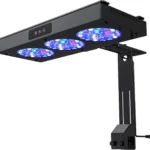
Saltwater fish tanks require specialised lighting if you wish to keep corals.
Corals are essentially a collaboration of animal and plant. The animal part of the coral sweeps food out of the water via sweeping tentacles or a mouth.
Living within corals is an algae known as zooxanthellae which photosynthesizes light into food and produces oxygen for the coral. Waste from the coral helps the algae in this process.
Whilst this is a complex topic on which there is tons of information, let’s try to keep it simple, for a reef tank you need lights that produce a particular spectrum towards blue and violet.
Some coral also require a higher PAR rating than others.
Modern LED lighting is the best solution for this and is now pretty much the standard.
For a fish-only tank, normal aquarium lighting will suffice.
Our Marine Aquarium Lighting Guide will give you all the information you need to make the right choice.
Return Pump
The return pump pumps the water from the sump back up into the main display tank and keeps the whole circular flow going throughout the saltwater tank system.
For saltwater fish tanks you should look for a pump that can produce a turnover/flow rate of 5 to 10 times the tank volume per hour. For example, a return pump for a 250 liter tank would equal a flow rate of 1250-2500 LPH.
Instructions on a new tank will give you the guidance you need on the size of the return pump required or see our guide on the Best Marine Aquarium Return Pump for more assistance.
Protein Skimmer
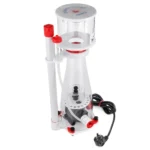
A protein skimmer in a saltwater fish tank removes organic compounds from the water such as fish waste or food.
Usually placed after the filter socks or cups, which remove larger particles, the skimmer removes microscopic particles by trapping them in bubbles which are then forced up its neck where they burst.
As the bubbles burst tiny particles collect on the side and then overflow into the collection cup and are later removed.
Whilst not absolutely necessary, protein skimmers are probably the best method to help you lower excess nutrients in your saltwater fish tank.
For more information read our article, Best Protein Skimmers for a Saltwater Tank.
Powerhead / Wavemaker
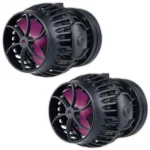
The flow created in your display tank by your return pump is usually insufficient to mimic the flow in the ocean over a coral reef so we need to give it a boost.
Additional pumps are added to the tank, at the sides or back, which act like fans to push the water through creating a more powerful flow throughout the tank.
Many powerheads can be set to different wavelengths and speeds so you vary the flow better recreating a natural environment.
Many corals have adapted over millennia to take advantage of these flows and will not thrive without them so in a coral reef tank, a powerhead / wavemaker is essential.
In addition, adequate flow throughout the tank will stop food and fish waste from settling and prevent some types of algae from developing.
For more information read our article, Best Saltwater Aquarium Wavemaker.
Heater
As we’re dealing with tropical fish, you’ll need to choose the right heater for your aquarium. Take a look at our guide, Best Rated Aquarium Heaters for assistance.
And we’d strongly recommend using a temperature controller to regulate your heater.
Substrate
Sand, gravel or bare bottom? We prefer the natural sand look but it’s very much up to you how you want the tank to look.
However, you need to bear in mind that certain fish (some wrasses for example) bury themselves in the sand overnight for protection and would not be happy in a bare bottom tank.
Many fish and critters eat by sifting through the sand for food particles and would possibly starve with no sandbed.
Likewise, if you desire to keep a Goby and Pistol Shrimp pairing, they need a deep sand bed.
Rock – Live or Dry
The rock in a saltwater fish tank is not just for aesthetics or to place corals on or fish to hide in. It’s a vital part of the whole filtration process and where the majority of the good nitrifying bacteria will live.
This bacteria converts toxic ammonia and nitrites from fish waste into, less harmful, nitrates which, to some extent, are used by some corals or are removed by your skimmer or water changes.
Dry rock can be purchased online or at your local fish store and will only become live after it’s been in the tank for a while as it becomes inhabited by nitrifying bacteria.
You may be able to get already live rock from your local fish store or a fellow fish keeper. That is, an actual piece of rock from an existing tank that is already biologically cycled.
Salt Mix
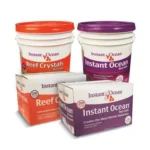
Unless you have ready and easy access to natural seawater, you are going to need to mix your own saltwater.
There are many different saltwater mixes available and each has its own merits. Some are higher in carbonates and calcium and are better if you are keeping corals but they tend to be more expensive and not necessary in a fish-only tank.
See our article, Best Salt for a Reef Tank for more information.
Whichever you choose, avoid mixing with tap water if you can. Even dechlorinated tap water will contain some nitrates, phosphates and dissolved solids which you will be trying to reduce later on.
You should, where possible, use RODI (Reverse Osmosis Deionized) water as the base for your saltwater. This is water that has been completely stripped of minerals, dissolved solids and chemicals.
RODI water can be purchased quite cheaply in many local fish stores.
Your chosen saltwater mix then adds the right minerals and chemicals to this neutral base.
Setting Up Your Tank
When setting up your saltwater tank for the first time be sure that it is flat and level and that the floor can fully support its weight.
Closely follow the assembly instructions for the tank and cabinet and make any adjustments to doors, etc before you add any water.
Connect up all the plumbing and install your return pump and heater but before you add anything else, test for leaks beneath the overflow area. Just pour a small amount of RO water into the overflow box and then check the plumbing connections underneath for leaks.
Adding the Rock
Next, add your rock and take time getting your rockscape to look how you want.
Bear in mind that if you want to add lots of corals you will need little ‘platforms’ or promontories where you can place them so they don’t block light from the ones below.
Look from the side, as well as the front and top.
Adding the Sand
Next, add your sand.
The reason you add the sand after the rocks is so the rocks are firmly down on the bottom glass rather than sitting on sand which could be moved later by a burrowing fish or critters causing your rocks to tumble.
Spread the sand around evenly, pushing it between the rocks.
If you are going to use live sand then only add it when you are also ready to add water.
Mixing the Saltwater
Let’s assume, for example, that we wish to make 50 litres of saltwater…
Start by adding your RODI water to a large food-grade container and measure exactly how much you have put in by adding, say, 10 litres at a time until it contains 50 litres.
Then, measure out the corresponding amount of your salt that will mix your saltwater to your desired salinity (Typically 1.024 – 1.026) for 10 litres of water. How much you need will be given in the instructions for your salt.
You will therefore need to add this amount of salt 5 times to the container.
Have a spare powerhead or pump running in the container to help mix the salt and make sure each batch of salt is fully dissolved before you add the next batch.
(If the saltwater is for a subsequent water change add a heater to the container to bring the water up to your tank’s temperature.)
Once the salt is fully dissolved it can be added to your tank.
You will need to repeat this process several times if your new tank is larger than 50 litres.
Adding the Saltwater To Your Tank
You can do this best by using a pump and pumping it out via a tube and slowly filling your main display tank to the overflow level, so it just starts to trickle over…
Then stop.
Next, fill your sump until it is a couple of inches from the top. And stop.
Start your return pump.
The water level in your sump will start to drop whilst that in the display tank will rise and begin to flow down the overflow.
Eventually, the level, in both the display tank and sump, will stabilise. Use the gate valve to make adjustments, following the instructions that came with the tank. You may also need to add or subtract water during the process.
You can now turn on your heater and slowly the temperature will rise to the level you have set.
There is no need to turn your Skimmer on at this point if you have one. There is nothing yet to skim.
However, before you add any fish or corals, you must now cycle your tank…
Cycling Your Saltwater Fish Tank
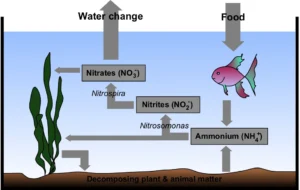
If you add fish or corals before your saltwater tank is fully cycled you may kill them.
Follow these links for more guidance on how to cycle your fisk tank and how you can speed up the process using the best bacteria supplements.
Adding Your First Fish
If possible, you should add new fish to a separate quarantine tank before introducing them to your main aquarium.
Keep a careful eye on them for signs of disease during the first few weeks and if anything does arise you can treat them in the quarantine tank.
Once you are sure the fish are in good health you can transfer them over to your main aquarium.
Unfortunately, diseases like Ich can still be introduced but they can be treated. Read our guides on Treating Ich In Your Aquarium and Common Marine Fish Diseases and Treatments to find out more.
Maintenance
Over time you will develop a regular maintenance schedule covering the following areas:-
Top Up
The water in an open-top saltwater tank evaporates out at a rate depending on the room temperature, etc., and needs to be replaced regularly.
Important Point: It’s very important to realise that when water evaporates from a saltwater tank, it evaporates as freshwater and leaves the salt content behind.
So when you top up the tank, to compensate for the loss of volume, you must top it up with fresh water.
This can be done manually but it is far better to automate the process using an Auto Top-Up system.
There are many different types available or your new tank may already have such a system installed.
Water Changes
A regular, 10 – 25 %, water change every one or two weeks will stop nitrates and phosphates from getting too high in your tank and also replace valuable minerals
Siphon out into a bucket and replace it with pre-mixed, pre-heated saltwater at the same temperature as your tank.
Testing
Testing the various parameters in your tank is both important when you are initially cycling the tank and on an ongoing basis.
Initially, the focus will be on levels of ammonia, nitrite and nitrate as the tank cycles but as it matures you will also need to test for phosphate, to prevent algae issues, and calcium and carbonate as growing corals deplete these.
For more detail on what you need to test in a saltwater fish tank see this article, How to Test Your Saltwater Fish Tank.
Filter Maintenance
If you’re using filter socks these will need to be thoroughly cleaned on a regular basis. You may find it easier to replace the socks with filter cups and add floss to those.
This can simply be tossed away when it gets too dirty and replaced.
Dosing
As calcium, carbonate and magnesium levels deplete over time in a coral reef tank you’ll need to add them back in by dosing these chemical elements.
For more information on dosing check out our article, Reef Tank Dosing Guide.
Clean Up Crew
As your tank matures you will need a bit of help to keep nuisance algae at bay and clear uneaten fish food and waste. That’s where your clean-up crew (CUC) of critters comes in.
For more information, see our article Best Clean Up Crew for a Saltwater Tank.
If this article, on how to start a saltwater fish tank, has wet your appetite, please feel free to look around the rest of our site for more information and advice.
Are you considering a freshwater tank? If so, check out our article, How to Start a Freshwater Fish Tank.
Saltwater Fish Tank FAQs
What is a good-sized saltwater tank for a beginner? – It would be best to start with a small or nano tank with a volume of 60 – 120 liters. A good saltwater fish tank starter kit is the easiest option.
These come with all the equipment you’ll need with lighting, a pump, a filter, and a heater. You’ll then just need to add sand, rocks, and fish of course.
What is the easiest saltwater fish to take care of? – Saltwater fish are no harder to care for than freshwater fish. However, you will need to research what their dietary requirements are and any other special needs.
Have a look at our guide on the Best Saltwater Fish for Beginners which lists fish that are both easy to keep and are ideal for smaller tanks.
How do I prepare salt water for my fish tank? – First, you need a good salt mix. Then mix the salt with RO water to your desired salinity. Follow the instructions that come with your salt mix.
Salinity should be between 1.024 – 1.026 sg, aiming for the higher end if you keep corals.
Can you use tap water for a saltwater tank? – No, it is not advisable to use tap water. Tap water contains nitrates, phosphates, and other dissolved solids which will lead to problems later on.
It is far better to use RO water which has all the harmful elements removed. Your salt mix then adds back the good elements that your saltwater tank needs.
